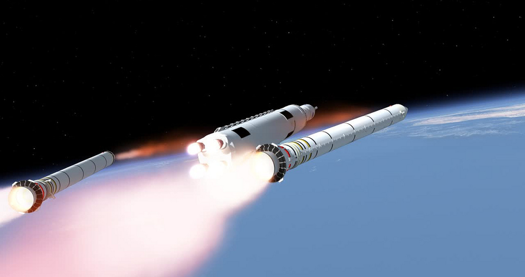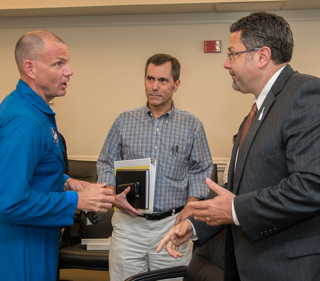
In August, the Space Launch System Program (SLS) passed its Preliminary Design Review (PDR). The next major milestone for the program is Key Decision Point C (KDP-C).
If SLS passes this decision point, it will progress from the formulation phase to the implementation phase of the program. It is not known how the current government shutdown will affect the timing of KDP-C. Most NASA websites are not operating during the shutdown, nor are public affairs offices.
“Moving from formulation to implementation is a huge milestone,” said James Whalen, a systems engineering consultant who teaches systems engineering classes at NASA field centers. “While there is great variability among programs, only 15%-25% of the program funding is generally spent in Phase A and B. The big chunk of funding is spent in the implementation phase.” The overall SLS development cost has been estimated at $18 billion.
Phase A is the Concept and Technology Development phase. Phase B is the Preliminary Design and Technology Completion phase, where the SLS program currently sits. Implementation includes everything from Final Design and Fabrication (Phase C) to Program Closeout (phase F).
KDP-C is the last major go-no-go point in the program’s development life-cycle. Once NASA grants permission for SLS to proceed, it becomes far less likely that the program will be cancelled. A program that has reached the implementation phase, particularly if it has some political momentum, stands a much better chance of surviving, even if it goes over budget. NASA Administrator Charles Bolden has repeatedly stated the centrality of SLS in the agency’s exploration plans, and SLS has received bipartisan support in both the House of Representatives and the Senate.
Constellation, the predecessor to SLS, which was cancelled in 2010, never reached KDP-C or the implementation phase.
Once it passes KDP-C, a program can begin making major hardware purchases and committing funds to contracts. “You might do some of those buys in the formulation phase, particularly with long-lead items,” says Whalen, “but the bulk of it comes in the implementation phase. That’s the normal process, at least.”
The PDR, which was completed in late July, is the first step in the KDP-C process. The culmination is a review of the program by the Agency Program Management Council (APMC). That council is chaired by NASA’s Associate Administrator (AA), according to NASA Procedural Requirement (NPR) 7120.5E. The current NASA AA is Robert Lightfoot, the former director of the Marshal Space Flight Center (MSFC) in Huntsville, Ala., where the SLS program is managed.

Three key documents are prepared in advance of KDP-C: the Program Commitment Agreement (PCA), the Program Plan, and the lifecycle cost estimate. The PCA documents top-level program requirements such as program objectives, schedule, and time-phased cost plans. The Program Plan is an agreement between the Mission Directorate Associate Administrator, the SLS Program Manager, and participating NASA field center directors. It documents the program’s requirements, the implementation approach, and how the program interfaces with other programs.
William Gerstenmaier is the Associate Administrator for the Human Exploration and Operations Mission Directorate, which oversees the SLS program and is located at NASA Headquarters in Washington, D.C. Todd May is the SLS Program Manager at MSFC.
The lifecycle cost estimate “forms the basis of the Agency’s external commitment to OMB [the White House Office of Management and Budget] and Congress,” according to NPR 7120.5E. In essence, this estimate defines the budget for the rest of the SLS development. As part of this budget estimate, the program provides a resource-loaded schedule and a Joint Cost and Schedule Confidence Level, or JCL. The JCL is a measure of the likelihood that the program will meet its cost and schedule targets. NASA requires managers to plan their programs assuming a JCL rating of 70 percent, unless a different number is approved by the NASA AA.
The JCL rating and the adherence of the budget estimate to the requirements set by Congress (or NASA) can have a significant impact on whether a program moves beyond KDP-C. In June 2012, spacepolicyonline.com reported that NASA had decided to cancel the Gravity and Extreme Magnetism Small (GEMS) Explorer mission. The budget estimate for that program was 20-30 percent more than was acceptable, with a JCL rating of 50 percent. GEMS was not permitted to pass KDP-C.
However, such a fate will probably not befall SLS. “A program of SLS’s importance to U.S. space capability is not likely to be cancelled at KDP-C,” says Whalen. If the APMC has reasons for concern, they would more likely re-work the budget and program plan, and then give the authority to proceed to implementation.




“A program of SLS’s importance to U.S. space capability is not likely to be cancelled at KDP-C,” says Whalen. It certainly will be GREAT to look forward to how and when the SLS will finally launch, instead of having to listen to poorly supported arguments that we shouldn’t have it at all! Full speed ahead with Orion/SLS!!! Thanks for the great news Daniel (but prepare for flak from the NASA-bashing howler monkeys)!
SLS development (and everything else NASA does, including Commercial Crew) brings a happy smile on my face and make me feel hopeful for the future!
I am glad to hear that SLS is moving forward (faster than the speed of government!). It will be nice to silence the “NASA-bashing howler monkeys”. Will KDP-C get us past EM-1 and 2, or are we only budgeted that far? (Of course right now, we aren’t budgeted at all!) Things continue to be murky still regarding missions and the role of SLS beyond LEO. Do you have any thoughts or insights about where we are going?
I see SLS/Orion as a beyond LEO capability first and foremost for the US. And I believe NASA sees it like that as well. That basically means that not having a strict destination right now isn’t an impediment. It’s like Commercial Crew, which is developed as a LEO capability for the US. Anti-SLS folks complain that SLS doesn’t have a specific set of goals set in stone. The same argument can be used for Commercial Crew as well. It doesn’t have any clients other than NASA at the moment, for transfering crew to and from orbit. Does that mean it isn’t worth it and that it should be cancelled? Of course not. Both programs provide different capabilities for different purposes, and are vital for the advancement of the space program.
I am thinking that a Shake Out Launch will be in 2018 for the Inspiration Mars private fly by mission since reading that NASA has taken on a much greater role in that endevor…Has anyone on the inside here heard as much?
I’ve read that NASA is assisting Inspiration Mars and is providing enthusiastic support and insight, but I haven’t read anything more than that. Dennis Tito also went on record stating that SLS is one of the vehicles he is considering for the mission (the others are ULA’s EELVs and Space’X Falcon Heavy). He also noted that more and more he realises that NASA’s support will be needed, if he’s to pull the whole mission off.
Inspiration Mars IMHO is one of the missions to definitely be anxious about, during the next few years.
I thought that Musk said he was not associated with Inspiration Mars at all and that while they had conversations at the early stages he pulled out and did not want to participate because of to many other obligations which created the opportunity to SLS since there are not any other launchers in the mix unless Russia has something but I have not heard them mentioned at all…I can’t help but think the current class of 8 astronauts 4 men and 4 women were picked now for this Inspiration Mars mission just like Apollo 8 was …This would really get NASA to the forefront again and is well worth the billions it would cost..
Yes, it would well worth it! A manned Mars fly-by would be the biggest and most significant development in spaceflight since the Apollo missions! (the other would be the development of nuclear propulsion).
I wasn’t aware that Musk pulled out because of obligations. Thanks for the info. I’ve only read that Space X’s president Gwynne Shotwell, stated that although they don’t have any official or otherwise involvement with Inspiration Mars, they would be happy to provide launch services for Dennis Tito, if the need would arise. Since Musk pulled out, the other viable launch vehicles would be ULA’s and the SLS.
It would be so awesome if NASA were to proceed with this mission (provided that everything sticks to the timetable)!
So far NASA has supported IM in principle. From what I’ve seen of their future programs, there’s no line item for funding or even providing for any unfunded SAA for IM. In addition, seems like a very risky mission and NASA seems to be particularly risk-averse these days.
Will SLS be ready for that time? Initial mission is 2017 and based on just about any other program commercial or government in history, it’s going to slip. There’s no maybe about it.
So far as I’m aware, Musk was never ‘in’ IM. He was always happy to commercially provide FH as a launch service but that’s about as far as it went.
SLS won’t be close to ready by 2018. Orion MPCV will be making it’s maiden flight on top of a delta heavy in 2017, and the estimate is that SLS will be ready for EM1 in 2021.
Actually, Orion MPCV is scheduled to fly on Delta Heavy in 2014 (unmanned), and on SLS in 2017 (EM-1, unmanned). The first manned mission (EM-2) is scheduled for 2021.
Great so lets pick up the pace and have the Orion/SLS ready to go by 2018 for the IM …Nasa does need to push more risk and take some chances…The sooner we get to MARS the better it will be for everybody on Earth…
Why?
Al Gore said Global Warming is going to destroy us all…Within the last 10 years strange things have happened on the Planet from a climate perspective….Two major tusnamis..creating a nuclear nightmere..hurricans to NY metroploitian area…a meterior hit that almost killed thouaands rather than just hurt them…Have you heard that yellowstone is a super volcano and ready to blow….Just to name a few….so I would rather my tax dollars go to NASA prepping the way to Mars than landing on some asteroid….because it really is time to find another planet to live on…one that is a little less global warming on…If you have’t noticed we do not have the A team in government to find the right solutions so between Nasa, spacex, boeing, lockmart and any other space co…..the time to go to Mars is sooner rather than later….
So, too far out for IM.
I am very glad that SLS has friends in the blogosphere now. Thank you all. The folks at Marshall really thank you for the kind words I’m sure. I have been advocating shuttle-derived heavy-lift as publiusr for many years–and this means a lot.
Any word on KDP-C yet (March 5, 2014)? I’ve been following this with some interest and haven’t seen anything.